60 Tera Bit / sec Explosion Fiber Optic Fiber Submarine Cable "FASTER" Landing Operation Site Suspended Repo, inside of one end of a cable connected to the United States and a relay station like this

Submarine cable connecting about 9000 km on the west coast of Japan and Asia with the cost of about 30 billion yen "FASTER"Was launched for construction. International consortia such as KDDI in Japan, Google in the United States, China Mobile International in China, etc. contributed, introducing the latest optical fiber technology60 terabits per secondIt was to launch a cable that made ultra-high-speed communication possible, starting from the coast of Shima-shi, Mie prefecture, so what kind of work is being carried out, and "A relay stationI decided to see how the inside of it is.
Conclusion of Joint Construction Agreement between Japan and the United States Optical Submarine Cable "FASTER" | 2014 | KDDI CORPORATION
http://news.kddi.com/kddi/corporate/newsrelease/2014/08/11/580.html
This time the cable landing was carried out is the coast of Shima-shi, Mie prefecture, located in the Pacific Ocean from the Kii Peninsula. It has been selected as the best place to connect West Japan and the West Coast, and has been launched in 2000Japan-US"In 2001 and"C2CIt will be the third international submarine cable landing.
That's why I came to KDDI's "South Shima Submarine Line Relay Station". There are no similar antennas that are often seen in relay stations in pure white and square buildings, so if you do not know, it should not seem that it is a facility where submarine cables are connected.

When arriving at 8 o'clock in the morning on the day of withdrawing work, many stakeholders were gathering in the tide bank immediately adjacent to the relay station.

The landing area this time is along the coast in the Shiga-shi Koga district that is directly connected to the Pacific Ocean. There was a peaceful place where the bicycle course which can run along the coast is maintained in the surroundings.

On the work site, there was a signboard for construction written "FASTER cable construction work". The contractor's orderer is "FASTER cable consortium" by companies such as KDDI and Google, and the constructor is "NEC Corporation", that is, NEC is undertaking all construction work. Normally, it is a submarine cable laying which is usually done jointly by 2 or 3 companies, but this time it is ordered only by NEC 1 company, and it seems that all the parts manufactured in Japan are used this time.

On the embankment, the local people also watch over the state of their work drunk.
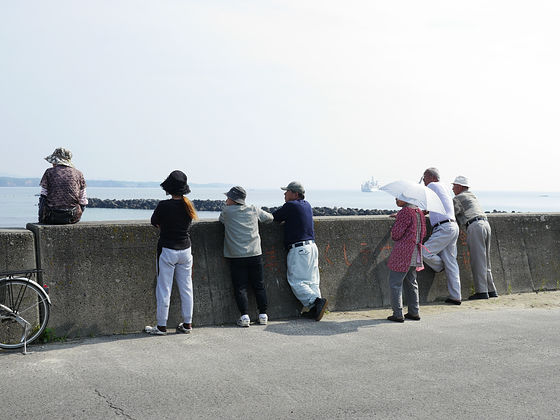
Turned to the sea side, tents and equipment for construction were installed.
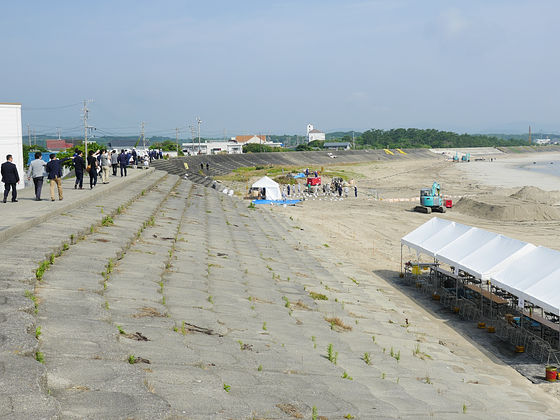
Tents for stakeholders, sandbags for construction, large-scale generators, etc., the atmosphere where work is going to be carried out will drift with plumps.
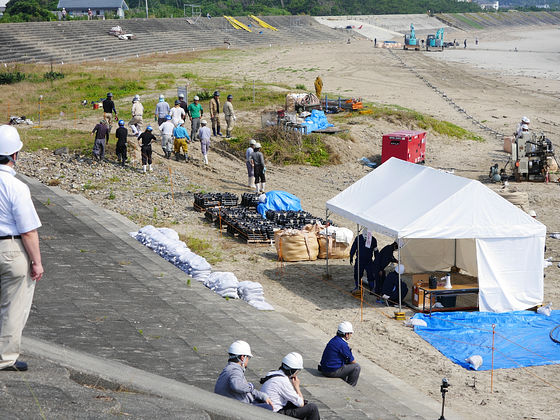
A mysterious black object was piled up next to the tent.

And in the offshore there is a special cable ship used for submarine cable laying "KDDI Pacific LinkYou can see the standby state.

The KDDI Pacific Link is a ship with a total length of 109 meters and a total gross tonnage of about 8000 tons and is a private ship that carries a submarine cable with a total extension of 6000 km class and installs cables and maintains it across the Pacific Ocean.
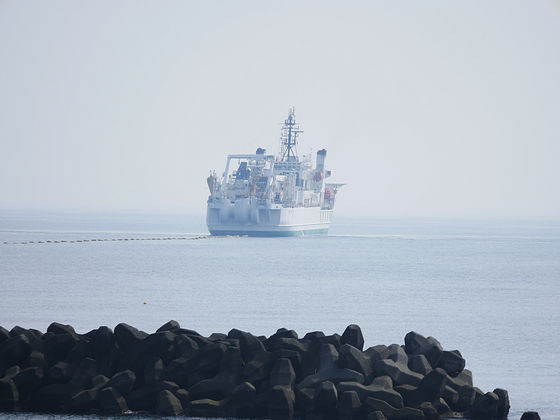
Because the hull is big, the KDDI Pacific Link can not approach the beach directly. For that reason, I will work at a berth 1.2 km off the coast to extend the cables to the beach and to withdraw them. Although there should be a distance of 1.2 km, it was a huge hull that seemed to only seem to be anchored at only a few hundred meters when actually witnessing it.
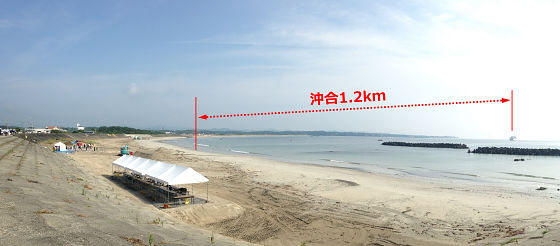
On the beach, heavy equipment for laying cables is on standby.
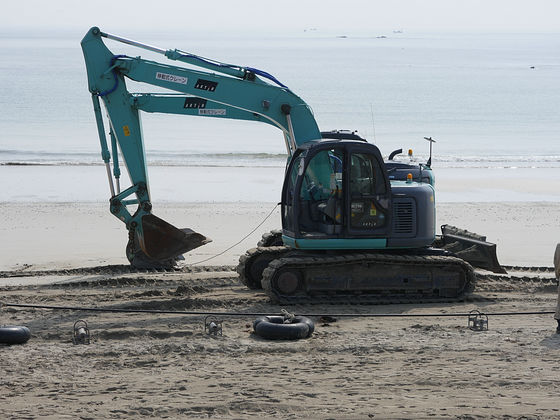
Then, a device for changing the direction of the cable that was lifted up to the beach "TurnshipIt was also on standby. But here the coverage will notice an unexpected situation ...!
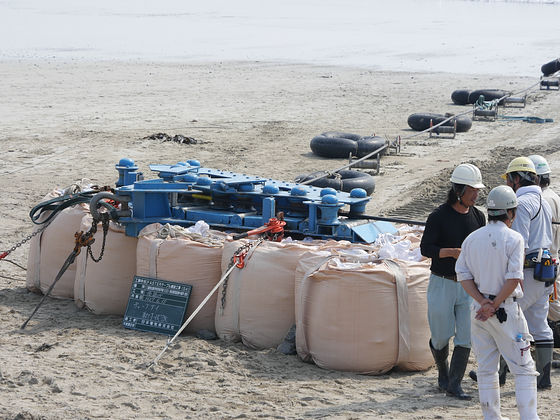
"I mean ... have you not reached the cable yet?Everyone's noisy in words of someone that says "I'm sorry. How awfully the unloading work carried well, the cable had arrived at the beach crisply before the news gathering team arrived! A mere moment that I missed a valuable moment a bit but it was a disappointing moment, but a specialized company that has undertaken the work of laying submarine cable for many years "KCSIt was a scene of being amazed at the goodness of the hands of.

Cables extending almost straight from the cable ship are carried with Pukapuka to the beach while floating on the sea surface by the tire tube.

From the ship to the beach and the cable that reached the beach change direction by 90 degrees using the turnship and proceed on the sandy beach towards the relay station enclosed by a square.
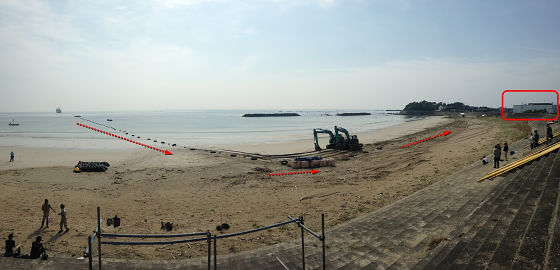
Close to the sandy beach of your favorite tire tube with this feeling.
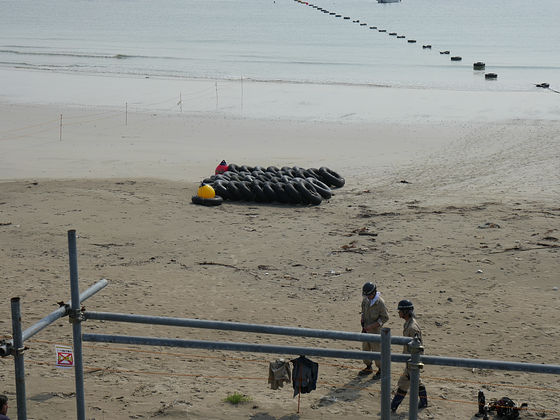
The tip of a landed cable was placed in the ceremony venue. The cable which goes around with Uonaune on the other side was placed directly on the white soil so as not to touch the ground directly.
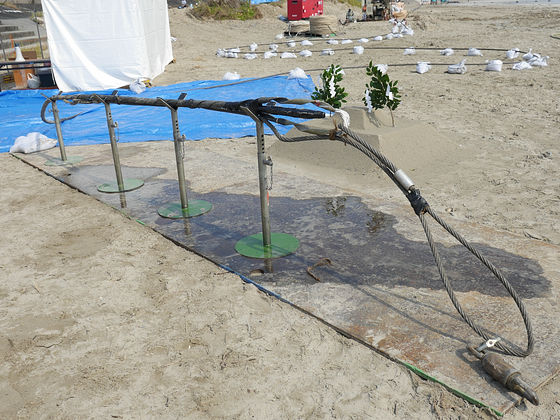
At the end of the black cable, a thick wire ring which was used at the time of withdrawing is attached.
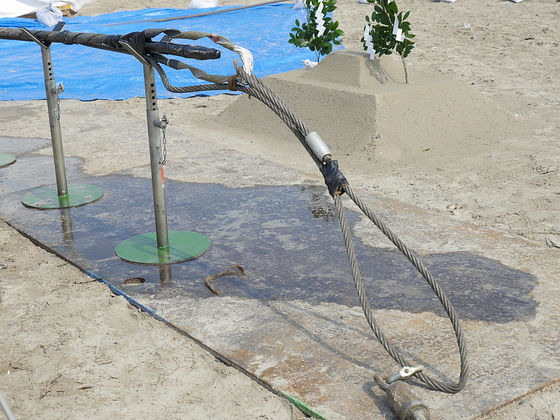
A black tape is wrapped around the end of the cable, so you can not see the cable body, of course. As it is, it passes through the soil in the ground and is to be drawn into the relay station after this.
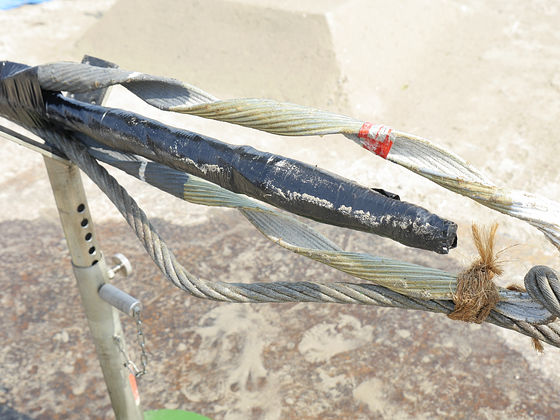
Ceremony started. The Kamiya performed by Kodairi's director of KDDI ... ...
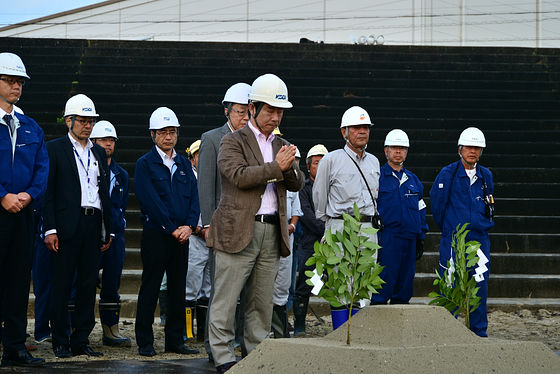
A champagne ceremony was held by directors such as Mr. Odaya according to the custom of the world.
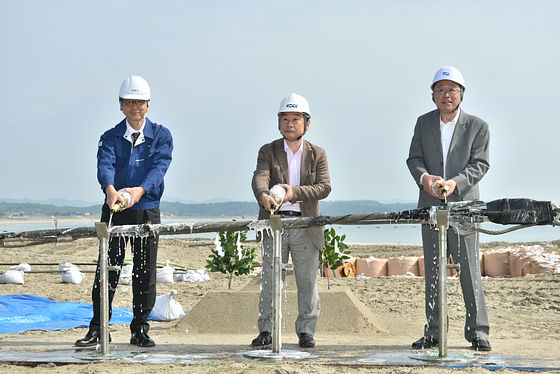
The worrisome (?) Champagne was a brand of 'Charles Ernail'. Of course it is in Champagne region of France.

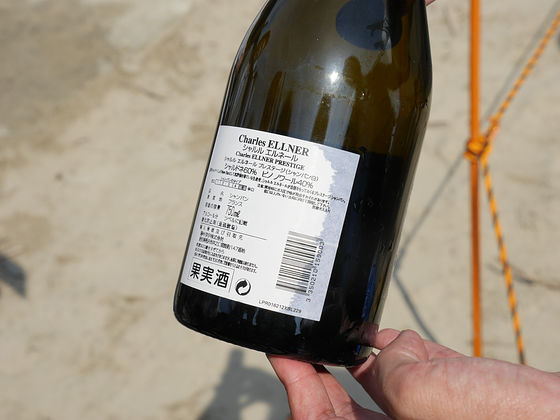
When the ceremony was over, the work of withdrawing and retracting was resumed. On the beach, workers take up the cables one after another.
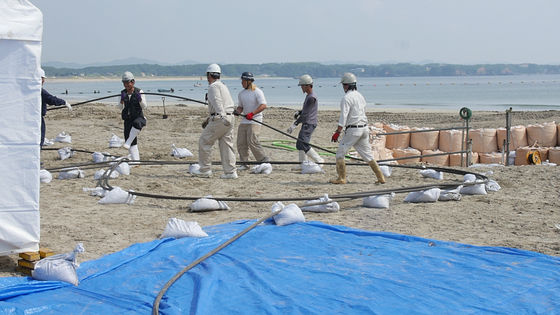
In this way, I draw a beautiful figure of eight. By winding in the figure 8, it is possible to prevent twisting and tangling of the cable.
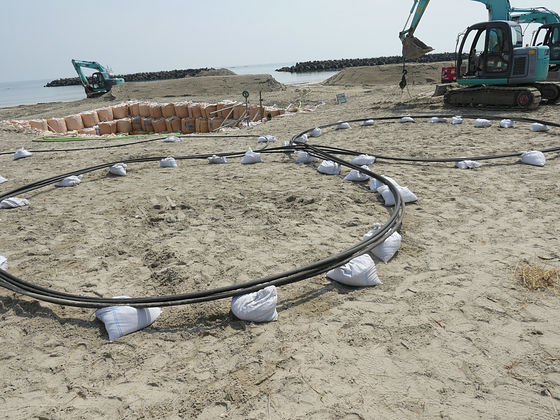
A dedicated hoisting machine is used for lifting the cable. The weight of the cable is3 kg per meterBecause it is also, it is almost impossible to work only with human power.

First of all, it is a cable that was landed on the beach in a straight line from the offshore, but eventually it turns around in the ocean and is led to a point of depression surrounded by the soil, and travels through the underground tunnel to the relay station You will be brought in. In areas close to the beach including the dotted line portion, the cable will be buried at a few meters underground to protect the accident of hooking by the bottom net and the cable itself.
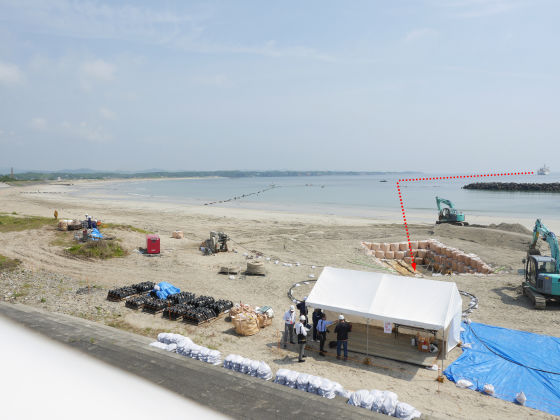
And the part for covering and protecting the cable during embedding was a mysterious black object beside the tent. When actually filling in the cable, we put the two parts up and down on the cable and connect them one after another.
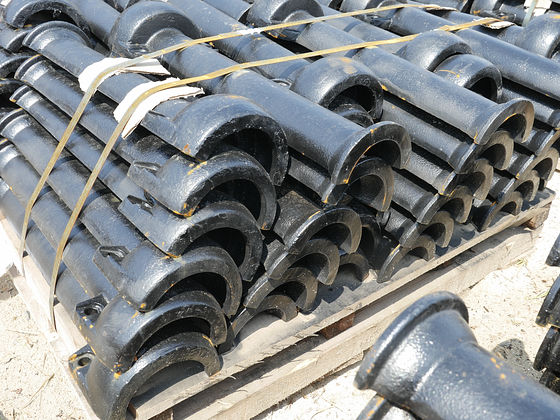
With this kind of feeling, the withdrawal work almost finished. In GIGAZINE, the KDDI submarine cable "SJCSince I am covering the landscape of the landed landings, I can see the whole and part of the actual work in the following article.
A site infiltration report to land the fiber optic cable supporting the Internet from the coast, this is a huge submarine optical fiber network "SJC" connecting Japan and Southeast Asia! - GIGAZINE
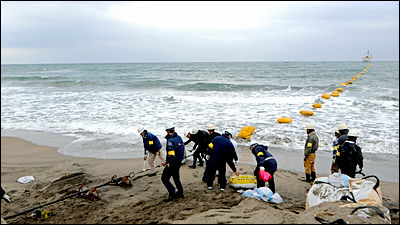
The cable that was pulled up and passed through the sandy beach passes through the basement of the tide bank and is drawn into the relay station on the land side. You can understand its positional relation by seeing the following movie in one shot.
Route in which submarine cable "FASTER" of 60 Tera / sec is landed off the coast and enters the relay station - YouTube
This time we will go inside the relay station. The building was very simple in appearance and there was a signboard of "KDDI" on the entrance.
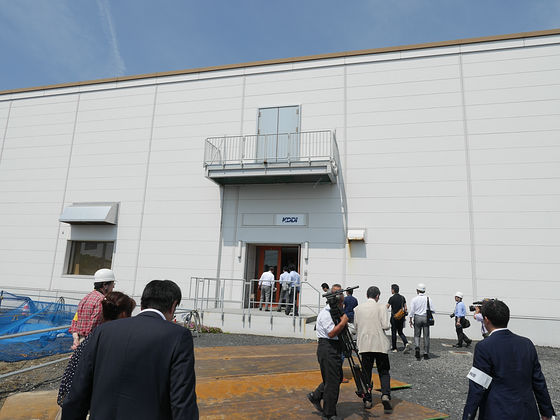
There was a big hole in front of the building with open mouth. The cable that came through the tide bank showed up again in this hole and is drawn further into the building.
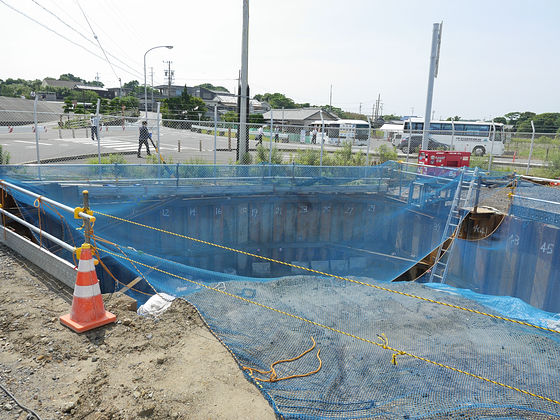
After entering the building and going down the ladder which continues to underground ... ...
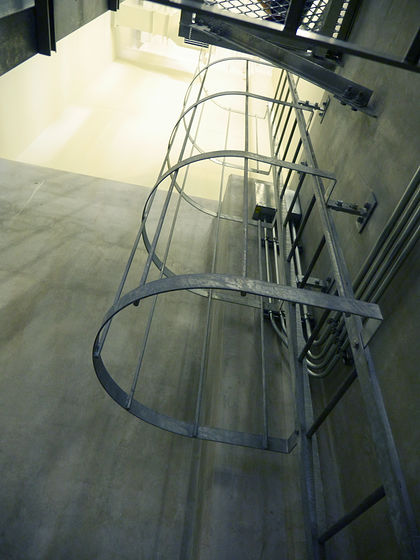
Beyond that, there was a space for concrete hammering, and it was a place where the optical fiber cable was drawn into the building. The cable departing from the west coast of America arrives just about 9000 km after this distance.

The incoming cable enters the device at the point you pointed to, and it is divided into the data line of the optical fiber transmitting the signal and the power line transmitting the electric power.

Then, the data line enters the relay station on the upstairs, and from there it leads to the Internet network covering Japan. Unfortunately, photographing of relay equipment was impossible for security reasons.
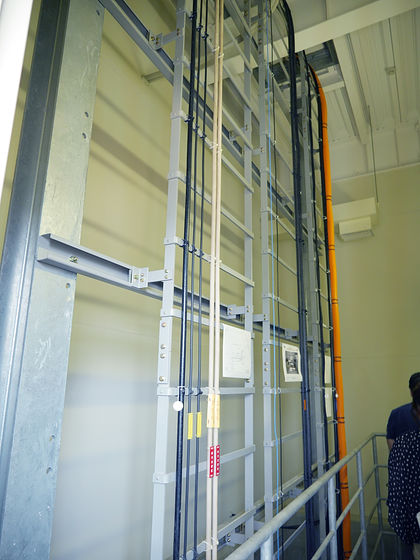
In the cable leading to the relay, the name of the Japan - US cable which started operation in 2001 was also written. Here is one of the cables that supports the Japanese Internet environment.
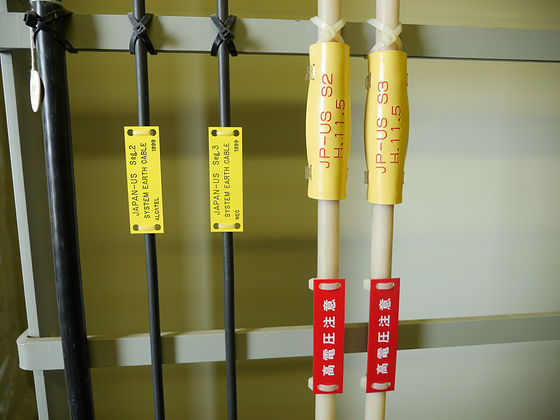
On the day, power supply facilities etc. were also made public. This is a switchboard unit that controls the power transmitted to the entire building and cable.
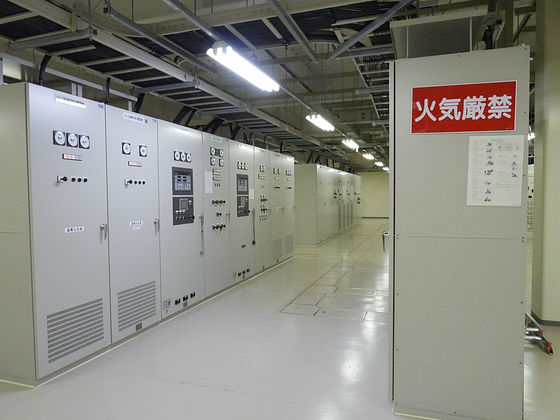
In addition, there is also a built-in power generator to prevent the Internet environment from being interrupted even in the event of a disaster or power outage.
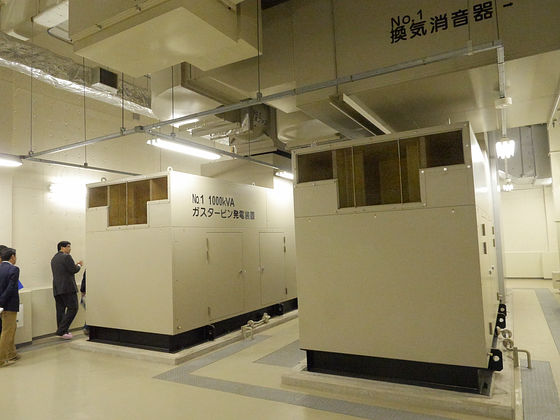
Two gas turbine power generators are on standby at any time and are able to supply power within 30 seconds.
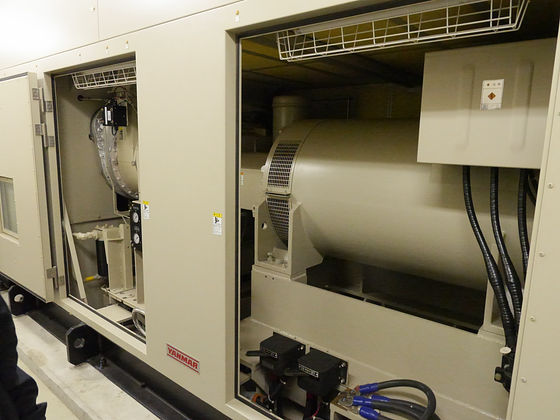
Until the in-house power generator starts up, a complete system is set up to ensure that the power supply is secured by an uninterruptible power supply (UPS) installed in a separate room.
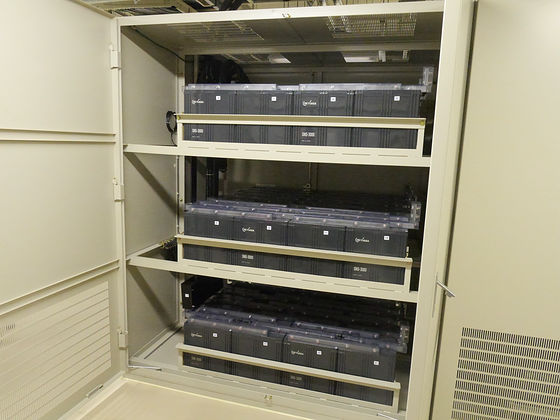
In the venue of the day, Hidekazu Oguchi, mayor of Shima (right) ran to celebrate laying FASTER.
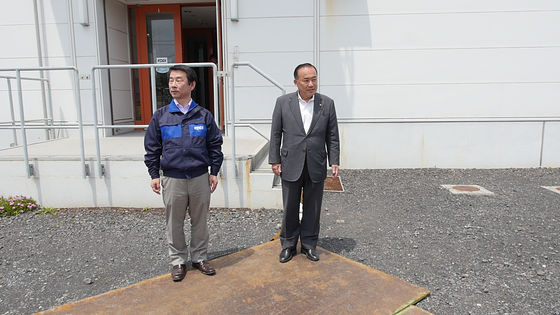
Shima City has decided to come to the venue of the coming Spring Summit in 2016 (major international conference), and it is strange that the operation of FASTER will be started around March 2016 which is almost the same as the Summit. The mayor also said that "I am extremely pleased that the FASTER that leads to the world will be started at that time, at the time of sending out to the world at the summit," commented with expectation.
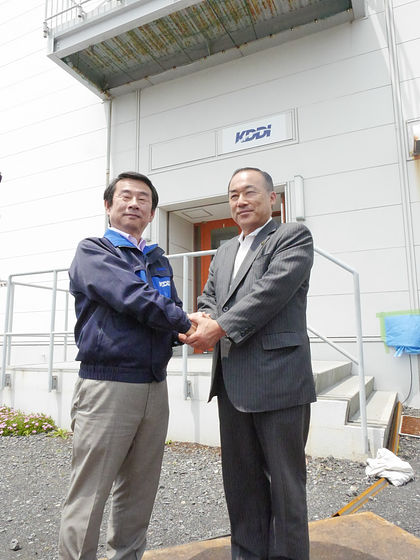
At the last press conference, Mr. Futaya gave an outline explanation of FASTER.
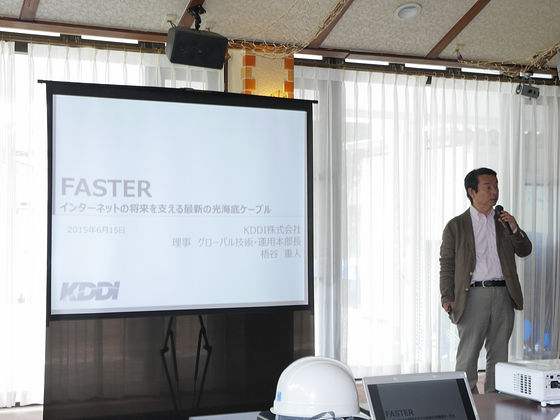
99% of Internet communications connecting Japan and the world is via submarine cables. Especially large volume movies such as YouTube and data such as applications used on smartphone are all brought to Japan via submarine cable.

YouTube supports 8K videoOr,Internet of things(IoT) "is expected to spread, the amount of communication between Japan and the United States is expected to continue increasing, and reinforcement of the submarine cable is indispensable to support this communication.

Even in the world of the Internet that incorporates the latest technology, it is physical cables that ultimately connect the worlds together. At the bottom of the ocean all over the world cables are running around to exchange data.
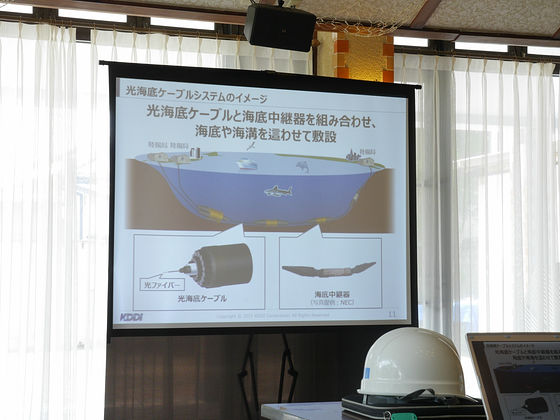
KDDI utilizes two cable ship to lay and maintain such a cable. "KDDI Ocean Link" is mainly maintenance, and "KDDI Pacific Link" which is also active this time is responsible for laying out new cables.
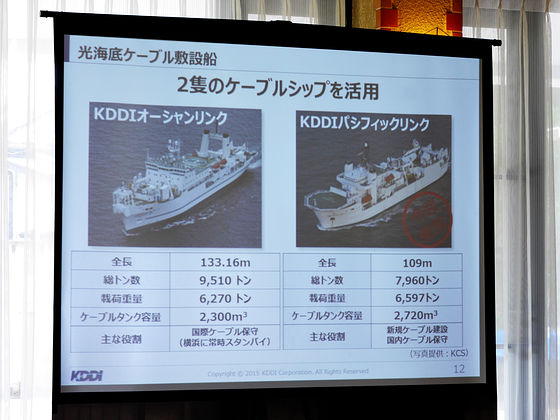
The unloading operation of the cable is surprisingly a world where craftsmen's skills are used. From the dawn of the submarine cable in the 1960's, cables are laid in almost the same appearance.

Along with the recent increase in traffic, the submarine cable has been reinforced many times. In 2010, KDDI, Google, and Southeast Asia companies jointly constructedUnityOperation started. The initial communication capacity is4.8 TbpsAfterwards20 TbpsIt has been reinforced.
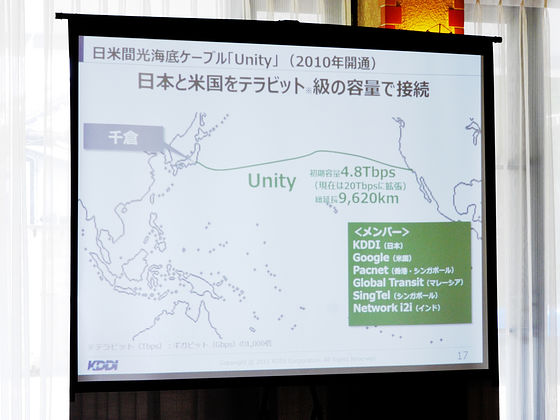
In 2013, we will link Japan and AsiaSJCOperation started. The original capacity is28 TbpsIt was, but also later45 TbpsIt has been augmented to.

And this time, it started to lay as a new line connecting Japan and the United States, capacity60 TbpsThat's why FASTER boasts.

Its features are "large capacity", "high reliability", "low delay" three.
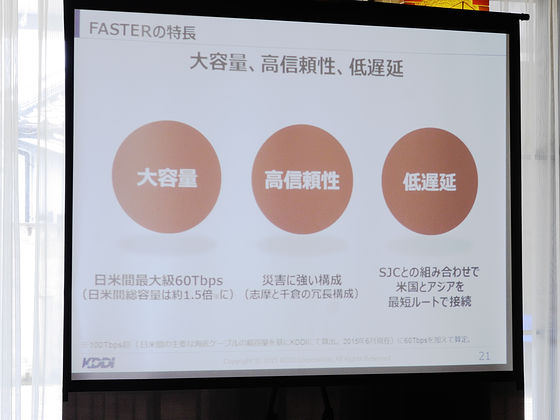
Looking at the past submarine cable in time series it is like this. You can see that the communication capacity is jumping abruptly like a double game, but this is due to various technological innovations, as well as market needs.
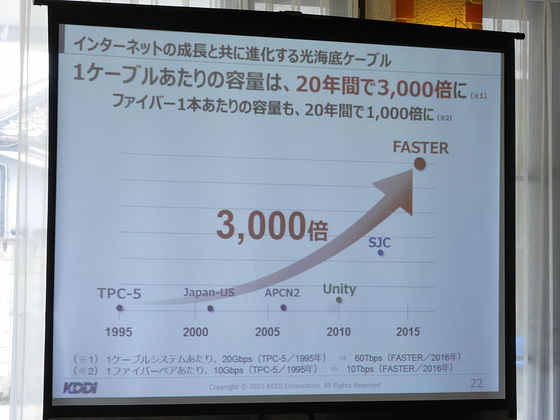
At the time in 1995 it was only a matter of 2 seconds to send the data for one DVD ... ...
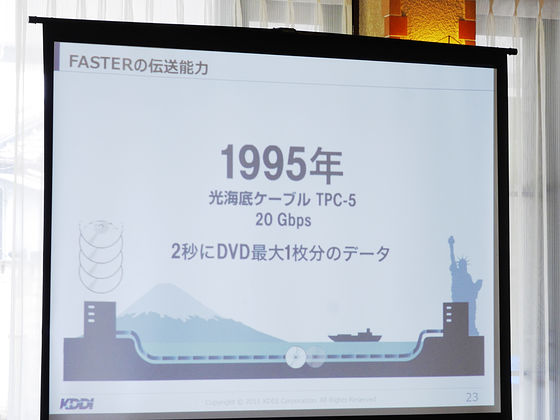
With FASTER, it is possible to actually send 3000 DVDs of data in the same 2 seconds. This means that about 100 lines of data can be packed and transmitted by placing light of different wavelength on one cableOptical wavelength multiplex communicationBecause there was breakthrough etc.

Also, on the Japanese side, we have realized redundancy of lines by flying FASTER at two places of Chika Prefecture Chikura and Mie prefecture Minami Shima, and we are ensuring high reliability even in the event of a disaster.

And the other one of FASTER will reach the state of Oregon on the West Coast of the USA. Actually, this route is the route that connects Asia ~ Japan ~ the shortest in the United States, and it seems that low delay of the signal is made possible by this.
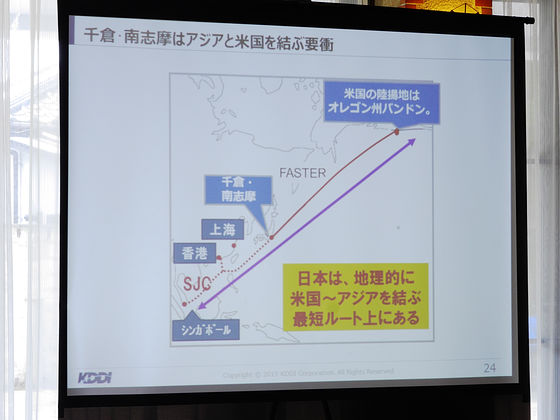
Starting with this time Shima Shima, FASTER will be launched in Chikura in Chiba Prefecture and also in Oregon State in the USA, and cables from east and west will be connected offshore. Operation will be started in the first quarter of 2016 after various tests have been conducted thereafter.
Even if new cables are laid, the burden on individual users never increases, and everything is a business that is being done to build a smoother and comfortable Internet network. It seems to be said that it is quite interesting that the muddy work like this is hidden in the background of the net that you normally use casually.
◆ 2015/07/03 14:55 Addendum
An article on FASTER installation was featured on Google + by Urs Hölzle, senior vice president of infrastructure related and Google Fellows. Mr. Herzl was the person who was employed by Google for the eighth person and he was also the first vice president of engineering at the company.
Last week the FASTER cable, a new transpacific network link with a theoretical ...

In addition, there are not many RTs from abroad in the article, and it seems that FASTER is interested also from other than Japan.
Related Posts:
in Coverage, Web Service, Hardware, Video, Posted by darkhorse_log







